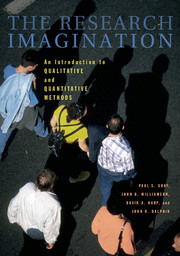Book contents
- Frontmatter
- Contents
- Preface
- 1 RESEARCH PROCESS
- 2 THEORY AND METHOD
- 3 RESEARCH DESIGN
- 4 MEASUREMENT
- 5 ETHICAL AND POLITICAL ISSUES
- 6 SAMPLING
- 7 SURVEY RESEARCH
- 8 INTENSIVE INTERVIEWING
- 9 OBSERVATIONAL FIELD RESEARCH
- 10 FEMINIST METHODS
- 11 HISTORICAL ANALYSIS
- 12 EXPERIMENTAL RESEARCH
- 13 CONTENT ANALYSIS
- 14 AGGREGATE DATA ANALYSIS
- 15 COMPARATIVE RESEARCH METHODS
- 16 EVALUATION RESEARCH
- 17 INDEXES AND SCALES
- 18 BASIC STATISTICAL ANALYSIS
- 19 MULTIVARIATE ANALYSIS AND STATISTICAL SIGNIFICANCE
- EPILOGUE: THE VALUE AND LIMITS OF SOCIAL SCIENCE KNOWLEDGE
- Appendix A A Precoded Questionnaire
- Appendix B Excerpt from a Codebook
- Author Index
- Subject Index
- References
17 - INDEXES AND SCALES
Published online by Cambridge University Press: 05 June 2012
- Frontmatter
- Contents
- Preface
- 1 RESEARCH PROCESS
- 2 THEORY AND METHOD
- 3 RESEARCH DESIGN
- 4 MEASUREMENT
- 5 ETHICAL AND POLITICAL ISSUES
- 6 SAMPLING
- 7 SURVEY RESEARCH
- 8 INTENSIVE INTERVIEWING
- 9 OBSERVATIONAL FIELD RESEARCH
- 10 FEMINIST METHODS
- 11 HISTORICAL ANALYSIS
- 12 EXPERIMENTAL RESEARCH
- 13 CONTENT ANALYSIS
- 14 AGGREGATE DATA ANALYSIS
- 15 COMPARATIVE RESEARCH METHODS
- 16 EVALUATION RESEARCH
- 17 INDEXES AND SCALES
- 18 BASIC STATISTICAL ANALYSIS
- 19 MULTIVARIATE ANALYSIS AND STATISTICAL SIGNIFICANCE
- EPILOGUE: THE VALUE AND LIMITS OF SOCIAL SCIENCE KNOWLEDGE
- Appendix A A Precoded Questionnaire
- Appendix B Excerpt from a Codebook
- Author Index
- Subject Index
- References
Summary
INTRODUCTION
This chapter is about the measurement of complex behaviors and attitudes. We know from earlier discussions that many of the variables that researchers manipulate are complex; for example, a number of separate mental and physical operations are required to produce the attitude of prejudice as well as discriminatory behavior, or the attitude of religiosity as well as pious behavior. Indexing and scaling are techniques for measuring these and other complex phenomena in social science.
Before some concrete examples are presented and the logic of index and scale construction is explained, it will be helpful to recall the basic principles of measurement outlined in Chapter 4 and the illustrations of questionnaire items in Chapter 7. An important way to increase both the reliability and the validity of abstract constructs – such as “happiness,” “alienation,” “tolerance,” and “anxiety” – is to operationalize them by using multiple indicators of the same phenomenon. A number of survey questions may be combined to assess the strength of a particular variable, the degree to which it is present, or its intensity. This idea will be explored in more detail.
Indexes and scales are devices for creating a single composite measure of behavior and attitudes out of a number of related indicators. Thus, they are particularly useful for summarizing complicated activities and orientations such as human mental capacity and people's perceptions, interests, and intentions.
- Type
- Chapter
- Information
- The Research ImaginationAn Introduction to Qualitative and Quantitative Methods, pp. 375 - 396Publisher: Cambridge University PressPrint publication year: 2007

